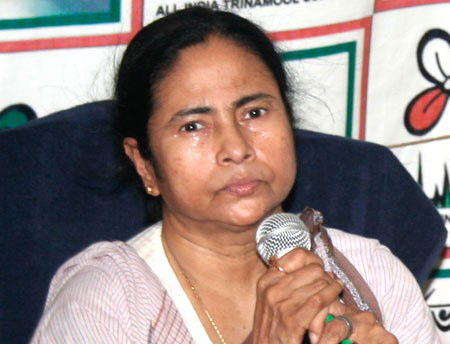Articles features
Mamata Banerjee: Didi with development mantra (Profile)

Kolkata, May 19
She worked as a milk booth vendor to battle poverty early in her life. Over the years, Mamata Banerjee became an uncompromising street fighter against the Communists in West Bengal. But, as she became the chief minister in 2011, Banerjee channelised her abundant energy to usher in development and implement socio-welfare schemes that ultimately helped her retain power in the eastern state.
Criss-crossing the state from Darjeeling in the north to Sagar in the south, Banerjee held over 100 administrative meetings in various blocks of the state's 20 districts, handed out lakhs of bicycles and shoes to school students and arranged distribution of foodgrain at Rs.2 per kg to around seven crore of the state's nine crore-plus population.
She doled out scholarships to girls, loans to the jobless youth for self-employment, arranged for free medicine and treatment in state-run hospitals, and most importantly, put in place a massive propaganda machinery to apprise the people about the Trinamool Congress government's development efforts and welfare schemes.
Banerjee's pet project 'Kanyashree' -- a cash-transfer programme for the education of girls -- has been recognised by Unicef. The government's "success stories" in building roads, even in remote blocks, ensuring drinking water and installation of rural street lights were played up on billboards, posters, print and television advertisements and the social media.
The frequent administrative meetings, which Banerjee -- the state's first woman chief minister -- described as "bringing the government to the people in the districts", saw the participation of all key ministers, top bureaucrats and police heads, with the chief minister donning the mantle of a hard task master, and even pulling up and suspending officials on the spot for non-performance.
The meetings kept the district administrations on their toes as the officers and staff virtually went on an overdrive to meet targets and execute projects.
The sum total of all these efforts enabled Banerjee to successfully fight back anti-incumbency and a no-holds-barred campaign by an aggressive Left Front-Congress alliance.
The somewhat murky election campaign -- which saw corruption charges taking the centrestage after the Narada video footages linking top Trinamool leaders to alleged bribery scandals were made public -- did at one time threaten to derail Banerjee's development plank.
On top of that, the under-construction Vivekananda Road flyover collapsed in north Kolkata on March 31, taking 26 lives, and triggering more allegations of graft, amid reports that the contracts was handed out to inexperienced people close to Trinamool leaders.
Banerjee chose to combat the challenge by telling the people to vote for her: "I am the Trinamool candidate in all the 294 assembly seats", she said. It was a calculated ploy to take the spotlight off the wrongdoing of her party leaders, and the increasing factional feuds in the Trinamool.
However, the poll success has seemingly overshadowed failings like her inability to tap big-ticket investments to create employment opportunities for the youth, control the 'syndicate' mafia and extortion rackets which have become a menace for entrepreneurs, and rein in hoodlums close to the Trinamool who have been running amok.
There were other lows too. A professor was arrested for online circulation of Banerjee's cartoons; she called a poor farmer a "Maoist" and ordered his arrest for demanding reduction in fertiliser prices; and termed the rape of an Anglo-Indian woman in Kolkata's Park Street as "a cooked up caseâ€. The irate opposition and the civil society dubbed her as "intolerant".
The daughter of a freedom fighter father who died when she was young, Banerjee had to fend for her family. For a while, she worked in a milk booth as a vendor-attendant.
With a post-graduate degree in thee arts, besides degrees in law and education, Banerjee was mentored early on in politics by Subrata Mukherjee -- now ironically one of her ministers.
She shot to fame in 1984 by upsetting CPI-M stalwart Somnath Chatterjee in Jadavpur constituency in her maiden Lok Sabha contest.
In 1991, she joined then prime minister P.V. Narasimha Rao's ministry but was unhappy because the government was indifferent to her proposal to develop sports. She lost the portfolio in 1993.
In 1998, she quit the Congress and formed the Trinamool Congress after accusing the Congress of not being serious in taking on the Communists in West Bengal.
She courted the Bharatiya Janata Party (BJP) from 1998 to 2001, supped with the Congress in the 2001 assembly polls, and again dated the BJP-led alliance in 2001-06 as she looked for ways to defeat the Left.
In between, she was the country's railway minister (1999 to 2001) and coal minister for a few months in 2004.
Her lowest moment came in 2004 when the Trinamool got just one seat in the Lok Sabha polls -- and the victorious Left decided to back the government of prime minister Manmohan Singh. But only four years later, the Left and Congress divorced.
During the Left Front rule under Buddhadeb Bhattacharjee, protests erupted in West Bengal over the the state government's decision to seize farmland to build factories - including Tata Motors' stalled Nano small car project. Banerjee lost no time and again launched an agitation that eventually saw the Tatas moving out of the state.
In alliance with the Congress, the Trinamool went from strength to strength and decimated the Left Front in the 2009 Lok Sabha polls, following which Banerjee again became the railway minister. She used the ministry to shower goodies on West Bengal, and virtually set up a parallel administration.
Finally, the Trinamool-Congress combine ousted the Left Front from power in May, 2011.
Banerjee still lives in her single-storey house in a dingy lane close to the famous Kalighat temple in Kolkata and wears her trademark cotton saris and inexpensive rubber chappals.
Beyond politics, Banerjee -- a spinster -- dabbles in painting and authors books. She is a good cook whose chicken and 'aar maachh' curry have earned much praise.
(Sirshendu Panth can be reached at s.panth@ians.in)



































